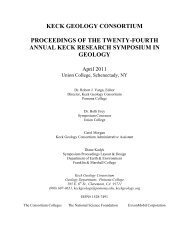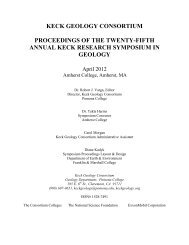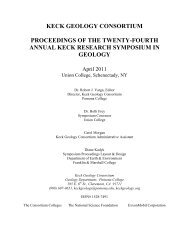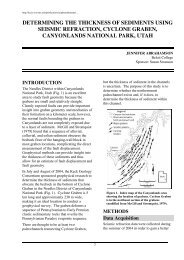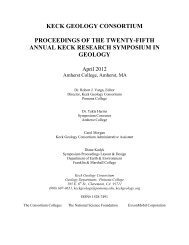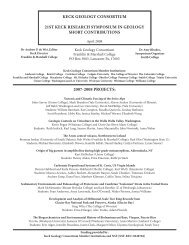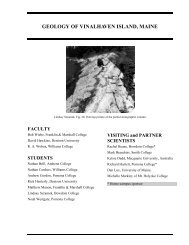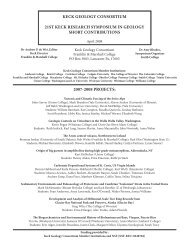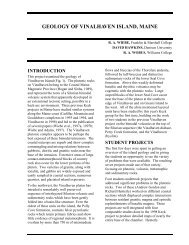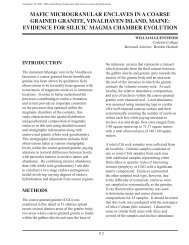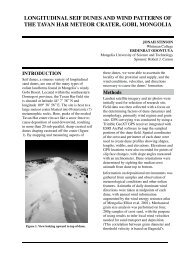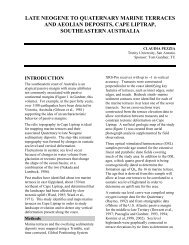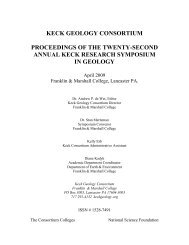volcanic stratigraphy and petrology of the northern snaefellsnes rift ...
volcanic stratigraphy and petrology of the northern snaefellsnes rift ...
volcanic stratigraphy and petrology of the northern snaefellsnes rift ...
You also want an ePaper? Increase the reach of your titles
YUMPU automatically turns print PDFs into web optimized ePapers that Google loves.
http://keck.wooster.edu/publications/eighteenthannual…<br />
Figure 2. Geologic map <strong>of</strong> sou<strong>the</strong>rn<br />
Laxaralsfjoll, NE Icel<strong>and</strong>.<br />
<strong>the</strong> Strjugsskard <strong>and</strong>esite (cf. Adzima, this<br />
volume). This unit is discontinuously overlain<br />
by tuffs, a tuffaceous breccia, <strong>and</strong> a few thin<br />
basaltic <strong>and</strong>esite lavas. Up section is a 30-80<br />
m thick flow-b<strong>and</strong>ed rhyolite. Above <strong>the</strong><br />
rhyolite is a discontinuous b<strong>and</strong> <strong>of</strong> tuffs, some<br />
containing large plagioclase crystal fragments.<br />
The upper 200 m <strong>of</strong> <strong>the</strong> ridge is ano<strong>the</strong>r thick<br />
section <strong>of</strong> basalt lavas.<br />
Several major NW-SE trending normal faults<br />
are found in <strong>the</strong> field area (Fig. 2), as are<br />
numerous small basaltic dikes, most <strong>of</strong> which<br />
were too small to map. A few large rhyolite<br />
dikes also crop out above <strong>and</strong> below <strong>the</strong> flowb<strong>and</strong>ed<br />
rhyolite unit. The rhyolite thickens<br />
near <strong>the</strong> center <strong>of</strong> <strong>the</strong> field area <strong>and</strong><br />
relationships become more complex. One<br />
particularly complex faulted <strong>and</strong> tilted block<br />
contains thick tuffs, <strong>and</strong>esite, dacite, <strong>and</strong><br />
rhyolite that may be at or near a center for <strong>the</strong><br />
silicic eruptions.<br />
Petrography<br />
In h<strong>and</strong> specimen <strong>the</strong> basalts exhibit an<br />
aphanitic groundmass with only a few<br />
phenocrysts <strong>and</strong> vesicles. Thin sections reveal<br />
textures that are typically intergranular to<br />
intersertal. The groundmass is composed <strong>of</strong><br />
predominately felty, but occasionally<br />
trachytic, plagioclase laths, clinopyroxene<br />
microlites, iron-titanium oxides, <strong>and</strong> glass<br />
(typically altered to brown palagonite).<br />
Phenocrysts are sparse: mostly 1-2 mm<br />
plagioclase <strong>and</strong> augite.<br />
The plagioclase phyric <strong>and</strong>esitic unit<br />
(Strjugsskard <strong>and</strong>esite) contains up to 35%<br />
euhedral plagioclase phenocrysts ranging up to<br />
several centimeters in diameter. The<br />
groundmass is generally dark gray to purple<br />
near <strong>the</strong> bottom <strong>of</strong> <strong>the</strong> flow, becoming more<br />
red toward <strong>the</strong> top. Flow b<strong>and</strong>ing (interpreted<br />
as commingling) is locally prominent, <strong>and</strong><br />
manifested in thin section by variation in<br />
crystal size <strong>and</strong> glass concentration. The<br />
groundmass contains small plagioclase laths<br />
with augite, iron-titanium oxides, some<br />
olivine, <strong>and</strong> glass. Plagioclase phenocrysts<br />
exhibit some oscillatory zoning, <strong>and</strong> several<br />
disequilibrium textures including sieve,<br />
resorption, rounded edges, <strong>and</strong> embayed<br />
margins.<br />
Rhyolites in <strong>the</strong> field are usually dark grey to<br />
purple <strong>and</strong> highly flow b<strong>and</strong>ed, although some<br />
isolated outcrops contain porphyritic obsidian.<br />
Rhyolite dikes are generally light colored <strong>and</strong><br />
very fine-grained. Alteration <strong>and</strong> <strong>the</strong> small<br />
grain size make mineral identification very<br />
difficult in thin section. A few small<br />
plagioclase laths are visible, occasionally with<br />
inclusions <strong>of</strong> clinopyroxene <strong>and</strong> zircon.<br />
Geochemistry<br />
Many Harker-type diagrams exhibit smooth<br />
trends suggesting that all <strong>the</strong> lavas are<br />
genetically related. Samples span a wide range<br />
93



